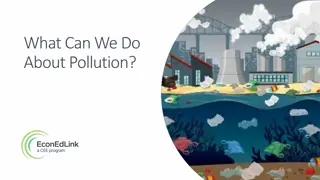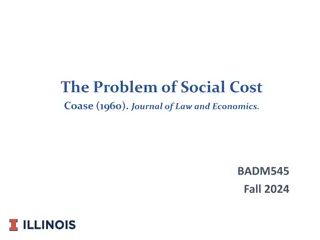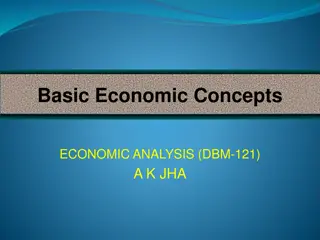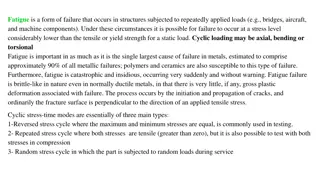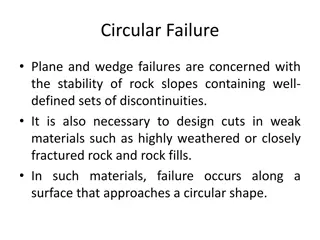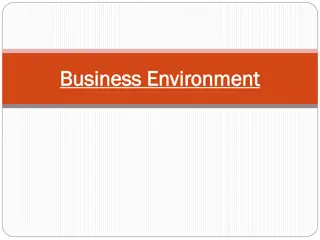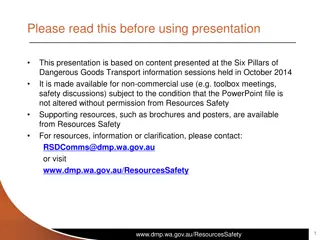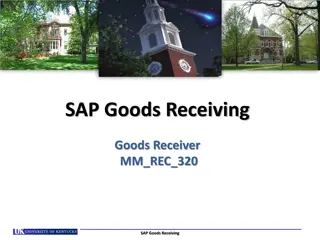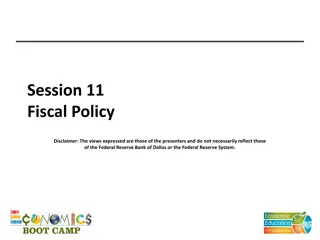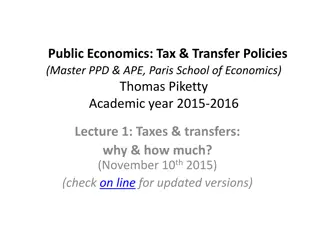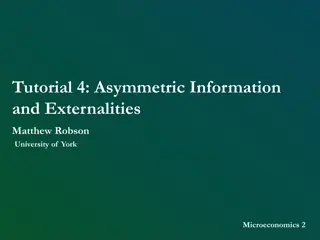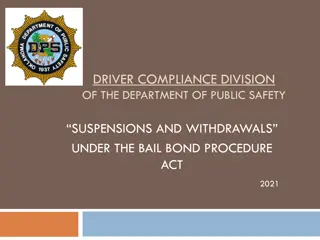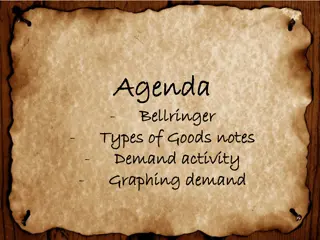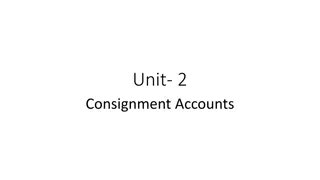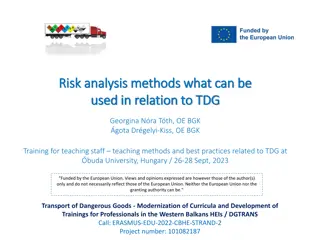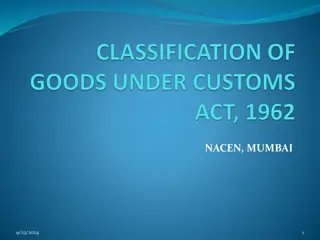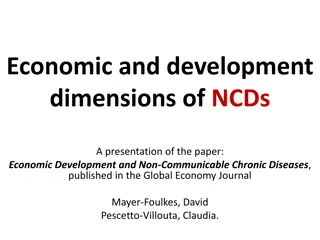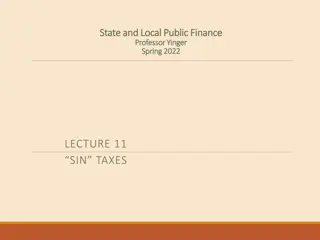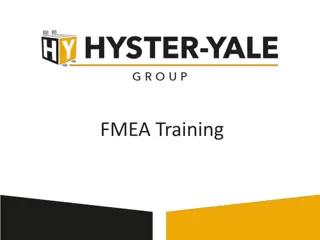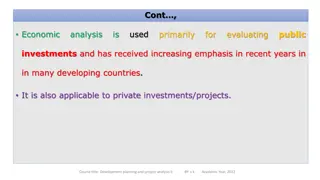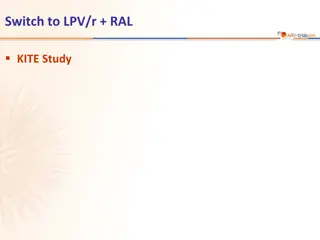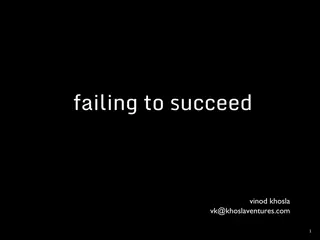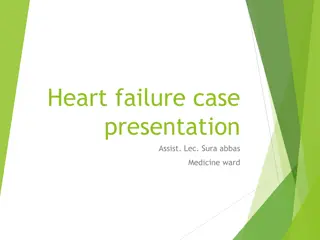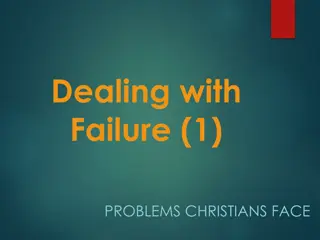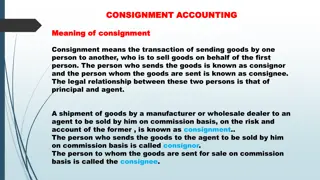Understanding Market Failure, Externalities, and Public Goods
Market failure occurs when the equilibrium is not Pareto efficient, often due to externalities where the actions of individuals or firms impact others without compensation. Positive externalities like bee pollination and negative externalities such as air pollution from power plants are examples. By modeling externalities, we can differentiate private and external costs to achieve socially efficient outcomes. Additionally, goods can be classified based on characteristics like rivalry and excludability, influencing access and consumption.
Download Presentation

Please find below an Image/Link to download the presentation.
The content on the website is provided AS IS for your information and personal use only. It may not be sold, licensed, or shared on other websites without obtaining consent from the author. Download presentation by click this link. If you encounter any issues during the download, it is possible that the publisher has removed the file from their server.
E N D
Presentation Transcript
Market failure, externalities and public goods. Gwen Arnold
Strictly speaking, the eqm is not Pareto efficient. NOT Pareto efficient NOT KH efficient EPA (2010)
An externality results when the actions of an agent (individual or firm) have an uncompensated effect on the wellbeing of other agents. Unintentional Market participants (demanders and providers) do not bear all of the costs or reap all of the rewards from the transaction. -K&O 2007 Typical examples Positive externality (external benefit): beekeeper who places bees in an area for honey not paid for the pollination services the bees provide for surrounding agricultural crops. Negative externality (external cost): power plant which does not pay for its emissions of green house gases or particulate matter and chemicals which affect human health.
To model externalities we will decompose social impacts into private and external. Total social costs = total private costs + total external costs TSC = TPC + TEC Marginal case: MSC = MPC + MEC social private costs or benefits: felt by the decision maker private external external costs or benefits: not felt by the decision maker
Market equilibrium vs socially efficient outcome: external costs (environmental damages) Story: a pulp mill damaging a downwind community with airborne emissions. What does the shape of this curve imply about damages? Is the additional damage from each additional unit of production constant? We will frequently think of the external costs specifically as the value of environmental damage . B Classroom exercise. Identify: A predicted market rate of output (based on private incentives/payoffs) market equilibrium total amount of external cost (env. damage) socially efficient rate of output (based on social payoffs) socially efficient total amount of external cost (env. damage)
Rival Nonrival Goods can be classified using two characteristics: Open access resources Pure public goods Non- excludable Club goods Private goods Excludable 1. rival: one person s consumption of the good diminishes the amount of the good available for others to consume nonrival: does not diminish 2. excludable: consumers are selectively allowed access to consume the good; often involves existence and enforcement of property rights nonexcludable: open to uncontrolled access by users, often involves absence of property rights or lack of enforcement
Continuum of private to public goods Rival Nonrival Nonexcludable Excludable Rival Nonrival Source: Fig. 5.2, Keohane and Olmstead (2007)
Open Access Resources (OARs) are an important source of externalities: Typical examples: fisheries, roadways, air and water bodies as waste sinks Rival Nonrival Open access resources Pure public goods Non- excludable Club goods Private goods Excludable Problematic canonical example The Tragedy of the Commons (TOC), Hardin, 1968 Grazing of cattle on a pasture open to all
Property Rights & the TOC Private property rights: exclusive authority to use, profit from and distribute property. Idea: he who does not expect to reap will not sow. Thus, property rights incentivize investment. (e.g. in investment in land, physical or human capital.) In contrast, goods which are owned communally are sometimes subject to the TOC, the tendency of any resource that is unowned--and hence nonexcludable--to be overused and undermaintained. Cowen and Tabarrok 2010
Open access resources Grazing story: the externality Note: this is an OAR example if we assume that there are no restrictions on use of the grassland (not the same as common property). The externality: Suppose many individuals or firms each draw upon some resource (e.g. harvesting fish, grazing cows, etc) such that total utilization is at or beyond the carrying capacity . (For this example, need the use to be a such a level that additional use involves a cost to all users.) If one individual increases their level of utilization (e.g. grazes an additional cow) there are two effects: 1. The expanding individual receives the proceeds from increased utilization. (+) 2. The return to each individual for utilizing each unit will subsequently be diminished. ( - ) Each individual feels (internalizes) the diminished return (per unit of the resource) to herself, but the diminished return imposed on all others is considered external it is ignored.
One feature of an OAR problem is nonexcludability, i.e. the lack of a (enforced) property right to the resource. A rational sole owner sets use to maximize profits (surplus). This will also be the socially efficient level of use. (Why?) With open access, typically use of the resource keeps increasing and the surplus is dissipated. (diagram) If the resource is environmental, then increased use will likely result in a stressed environment.
Connecting the framework of Hardin s The tragedy of the commons to our models for (1) market equilibrium, (2) socially efficient outcome, and (3) market failure/externality. Market forces/ incentives Quotes from TTOTC: In economic affairs, The Wealth of Nations (1776) popularized the "invisible hand," the idea that an individual who "intends only his own gain," is, as it were, "led by an invisible hand to promote ... the public interest". FTWE Adam Smith contributed to a dominant tendency of thought that has ever since interfered with positive action based on rational analysis, namely, the tendency to assume that decisions reached individually will, in fact, be the best decisions for an entire society. [comment: yes but only if certain conditions are met which preclude market failure.] If this assumption is correct it justifies the continuance of our present policy of laissez-faire in reproduction. (p. 1224)
Institutions and common property Elinor Ostrom Only woman to win the Nobel Memorial Prize in Economic Sciences (2009). Not an economist. challenged the conventional wisdom common property is poorly managed and should be completely privatized or regulated by central authorities. Studied: user-managed fish stocks, pastures, woods, lakes, and groundwater basins (Source: Economic Sciences Prize Committee of the Royal Swedish Academy of Sciences)
Institutions & common property: a critique of conventional economic advice When markets fail, economist advocate for State intervention without asking how incentives are generated within State bureaucracies to improve performance. The (mistaken) conventional wisdom/accepted theory: voluntary self- organization to provide public goods or manage common-pool resources is highly unlikely Ostrom and Ostrom 2003
Do common-pool resources always result in the TOC? Results from a wide selection of field studies: Common-pool resource users have developed a variety of institutional structures for cooperation, with and without the help of outsiders. Also, there are many cases in which this fails to occur. Although tragedies have undoubtedly occurred, it is also obvious that for thousands of years people have self-organized to manage common-pool resources, and users often do devise long-term, sustainable institutions for governing these resources (Ostrom et al. Science, 1999) Ostrom and Ostrom 2003 Central empirical and theoretical question: Why in some instances and not others?
8 Keys to a Successful Commons (Ostrom, 2010) 1. 2. Define clear group boundaries. {Common prop. degree of excl.} Match rules governing use of common goods to local needs and conditions. {Advantage of common prop mgt customization.} Ensure that those affected by the rules can participate in modifying the rules. Make sure the rulemaking rights of community members are respected by outside authorities. Develop a system, carried out by community members, for monitoring members behavior. Use graduated sanctions for rule violators. Provide accessible, low-cost means for dispute resolution. {Possible role for government invest in institutions.} Build responsibility for governing the common resource in nested tiers from the lowest level up to the entire interconnected system. 3. 4. 5. 6. 7. 8. Source: Ostrom (Feb. 2010): http://www.yesmagazine.org/issues/america-the-remix/8-keys-to-a-successful-commons
Rival Nonrival Nonexcludable Excludable Rival Nonrival Source: Fig. 5.2, Keohane and Olmstead (2007)
Rival Nonrival Pure public goods are a common source of external benefits (and hence of potential market failure). Open access resources Pure public goods Non- excludable Club goods Private goods Excludable clean air SHUTTERSTOCK
In cases of external benefits the market left to itself will normally undersupply the good in question. Why? First: recall what we mean by undersupply Less than the socially efficient level Rival Nonrival Open access resources Pure public goods Non- excludable Because: an individual or firm which bears the cost of supply will enjoy only some fraction of the total social benefit. Club goods Private goods Excludable Individuals then have an incentive to free ride : contribute less than their true WTP.
Private provision of a pure public good Setting: housemates Alice and Bob must individually decide on what level of contribution to make to the public good of household cleanliness. MC is the same for both. MB curves are given below. Note that in this simple example, society and the public is comprised of just Alice and Bob. Who values cleanliness more? What level of cleanliness would each desire on their own? Who would we predict to free ride MC What is the aggregate MWTP (aka SMB here) for the public good? What is the socially optimal level of cleanliness? QB ***MC curve detail: MC increasing because of increasing effort needed for each additional unit (NOT due to increasing opportunity cost of time). Source: Keohane and Olmstead (2007)
(private good/OAR) Recall: aggregate MWTP for a rival good ? Aggregate MWTP for a rival good: Heuristic: sum demand curves HORIZONTALLY for a private good for any given dollar value (p) sum up the quantity demanded (q) across all individuals: qAgg(p) = qA(p) + qB(p) + qC(p) Classroom exercise: Calculate aggregate quantity demanded at p = 8. qAgg(15) = qA(15) + qB(15) + qC(15) = 4+0+3 = 7
Aggregate WTP for a nonrival good (pure public/club) Example: Lake pollution. Currently pollution concentration is at 5 ppm. Identify (graphically and in the table) Aggregate demand for water quality (vertical sum in graph): AMWTP(q) = MWTPA(q) + MWTPB(q) + MWTPC(q) Note this is different than for a rival good since for a non-rival good we are valuing the same unit across each individual Agg. MWTP or Agg. demand , D
Efficient provision of a nonrival good MC Exercise: What is the socially efficient level of pollution? What level of contaminant would be reached if only Homeowner A paid for cleanup? Hint: superimpose MC curve on Homeowner A s figure. Would B or C voluntarily contribute to further cleanup? Connect this to the idea of free-riding Aggreg. WTP
The Tragedy as collection action problem. First, a diversion: Adam Smith was wrong.
Game theory Saturday Morning Breakfast Cereal by Zach Weinersmith http://www.smbc- comics.com/comics/20100605.gif
Game theory & international environmental agreements (IEAs) Game theory: the study of multi-agent decision problems where the payoffs to actions depend on the actions of others. A simplified story of the transboundary/international pollution problem: Two countries, A & B, contribute to emissions of a transboundary pollutant. Currently, neither A nor B is addressing the pollution issue but both are considering doing so Discrete strategies: each country will choose either to contribute or shirk (not contribute) Non-cooperative game theory: A & B will not negotiate but rather simply choose (irreversibly) a strategy. Each behaves individually rationally Information is complete: payoffs are fixed and common knowledge Static, one-shot game: the actions of A & B are selected once, simultaneously, and are permanent. Any agreement to take action must be self-enforcing there is no higher authority to impose constraints. Finus, M. (2001)
The cost/benefit structure Assumptions: Costs: effective action: 4 total If one country takes effective action ( contributes ) its costs are 4. If both contribute then each faces a cost of 2. no action: zero cost Benefits effective action: 3 each Both countries receive benefits of 3 regardless of whether the effective action is due to the efforts of one or both countries no effective action by either: 0 each **This example based on Keohane and Olmstead (2007, p. 79)
Assumptions: Costs: effective action: 4 total If one country takes effective action ( contributes ) its costs are 4. If both contribute then each faces a cost of 2. no action: zero cost The payoff matrix: for each possible outcome, the net benefits to each country are give by: (NBA, NBB) Country B Contribute Shirk Benefits effective action: 3 each Both countries receive benefits of 3 regardless of whether the effective action is due to the efforts of one or both countries no effective action by either: 0 each (1,1) (-1,3) Contr. Country A Shirk (3,-1) (0,0) Note: payoffs to A depend on the choice of B and vice versa.
Nash equilibrium Solution process: check whether each possible outcome satisfies the NE condition: 1. For each player and for each strategy, determine the other player s best response (and underline that payoff) Consider B s best response: If A contr. should B shirk or contr.? If A shirks should B shirk or contr.? Consider A s best response: If B contr. should A shirk or contr.? If B shirks should A shirk or contr.? Country B Contribute Shirk Contr. (1,1) (-1,3) Country A 2. The pair of strategies {s*A, s*B} is a NE if each players strategy is a best response to the other s (i.e. if both payoffs are underlined). Shirk (3,-1) (0,0) Is the predicted outcome Pareto inferior (i.e. can one agent be made better off without making any other agent worse off)?
Prediction of the equilibrium Any agreement to take action must be self-enforcing Each player s predicted strategy must be that player s best response to the anticipated strategy of the other player. C: contribute S: shirk The strategy of player i, given by si, is chosen from the set {C,S} The strategies {s*A, s*B} are a Nash equilibrium (NE) if, for each player, s*i is player i s best response to the strategy specified for the other player. (There is no incentive to deviate.) Gibbons (1992)
Prisoners Dilemma in Action: Golden Balls - 100,000 Split Or Steal? 3/14/08
Model extensions: To capture the wide variety of IEAs requires model extensions: N>2 countries Coordination Dynamic/repeated games (finite, infinite) Continuous strategy space Negotiation models Coalition models See Finus (2001)
In Memoriam: whitehouse.gov/energy/climate-change https://web.archive.org/web/20170119044801/https://www.whitehouse.gov/energy/climate-change
Common property is not open access (Ostrom et al. Science, 1999) COMMON/GROUP PROPERTY OPEN ACCESS INDIVIDUAL PROPERTY no owner single owner Property held by a group or in common may be governed by formal or informal institutions From explicit rules to informal social norms
Example: common/group vs. government property (mgmt) Ostrom et al. Science, 1999, pp. 280
Institutions & common property Ostrom findings: resource users can create sytems of governance to manage a shared resource by generating explicit rules about what people can use what their responsibilities are how they will be punished if they break the rules Key departure from the idea of the TOC: When resource users interact repeatedly over time clever punishments for wrongdoing (are) feasible . Credible threats enable cooperation. The Economist (2009)
Institutions and common property Any single, comprehensive set of formal laws intended to govern a large expanse of territory containing diverse ecological niches is bound to fail in many of the areas where it is applied. (p. 10) shorthand no panacea Policy recommendation: as opposed to imposing uniform management rules from above, focus on building the capacity of resource users to self-organize. Courts (efficient, fair and honest), effective property rights, and infrastructure (e.g. highways). Develop policy that works in concert with the ways in which local collective efforts evolve and operate. Ostrom and Ostrom 2003
Ostrom v. Hardin Fran: So, are you saying that Hardin is sometimes right? Elinor:Yes. People say I disproved him, and I come back and say No, that s not right. I ve not disproved him. I ve shown that his assertion that common property will always be degraded is wrong. But he was addressing a problem of considerable significance that we need to take seriously. It s just that he went too far. He said people could never manage the commons well. Elinor: No panaceas! We tend to want simple formulas. We have two main prescriptions: privatize the resource or make it state property with uniform rules. But sometimes the people who are living on the resource are in the best position to figure out how to manage it as a commons. Fran: Is there a role for government in those situations? Elinor: We need institutions that enable people to carry out their management roles. For example, if there s conflict, you need an open, fair court system at a higher level than the people s resource management unit. You also need institutions that provide accurate knowledge. The United States Geological Survey is one that I point to repeatedly. They don t come in and try to make proposals as to what you should do. They just do a really good job of providing accurate scientific knowledge, particularly for groundwater basins such as where I did my Ph.D. research years ago. I m not against government. I m just against the idea that it s got to be some bureaucracy that figures everything out for people. Korten and Ostrom (2010)



